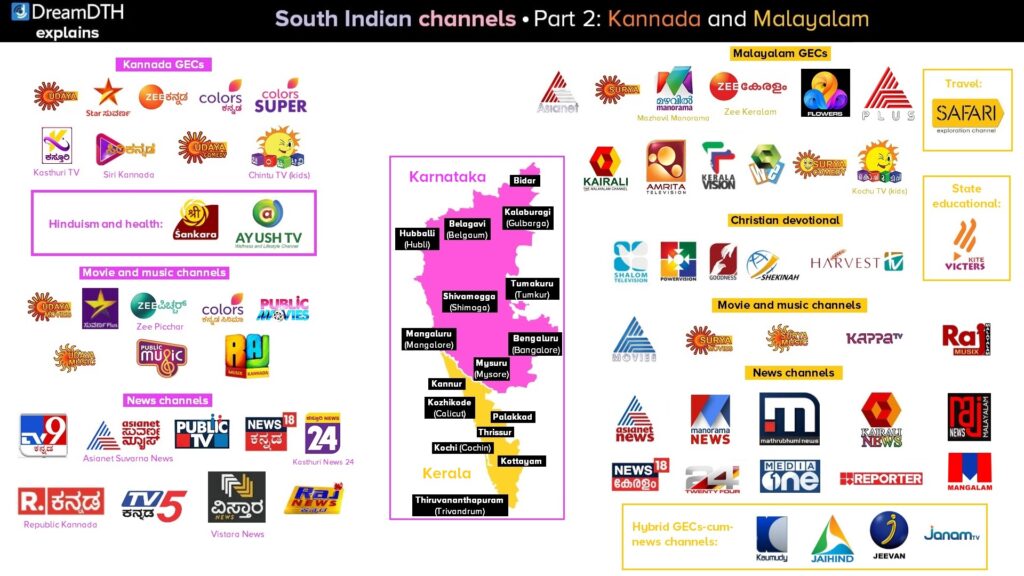Malayalam channels
Like Tamil, Malayalam has a number of independent channels, many of which are owned by political parties; but unlike Tamil broadcasters like Jaya, Kalaignar, Polimer and Mega, the equivalents in Kerala like Amrita, Jeevan, Jaihind and Kaumudy are typically a single channel without sister channels. Also, even though Viacom18’s Colors brand is absent from Kerala, its news counterpart News18 is present regardless, unlike Telugu where Network18 is prohibited from entering due to an agreement with ETV.
That said, there are still several multi-channel broadcasters that are specific to Kerala: Manorama (Mazhavil Manorama and Manorama News), owned by the Malayala Manorama publishing group that is as dominant here as ABP is in West Bengal; Mathrubhumi (Mathrubhumi News and Kappa TV), run by Mathrubhumi, the state’s second-largest newspaper after Malayala Manorama; Kairali (Kairali TV, Kairali We and Kairali News — formerly known as Kairali People), one of the oldest broadcasters, operating since 2000; and Insight Media City (Flowers TV and Twenty Four), a much younger network that has risen in popularity over a short period.
Unlike in Tamil, Telugu and Kannada — where the respective bases are Chennai, Hyderabad and Bengaluru (Bangalore) — Malayalam channels are equally spread across two cities: the state capital of Thiruvananthapuram (Trivandrum) and the commercial centre of Kochi (Cochin), with the Malayala Manorama group being headquartered in Kottayam near Kochi. Also, since the Gulf countries — the UAE, Saudi Arabia, Qatar, Kuwait, Bahrain and Oman — have the largest diaspora of Malayalis, the biggest GECs all have dedicated feeds for the Gulf, in addition to covering other regions like Southeast Asia and Europe.
Note that Zee Malayalam News is not included here, since it is available only on digital platforms, like Zee Tamil News — and unlike Zee Telugu News and Zee Kannada News, which proceeded to launch satellite versions after their digital débuts in 2022. In fact, there are very few Malayalam news channels compared to the other three languages — with some like Indiavision having shut down in the past — and no satellite movie channels outside Surya Movies and Asianet Movies, with neither Zee nor Manorama nor Kairali having launched one.
Table of major Malayalam broadcasters
| Broadcaster↓ Genre→ | GEC | Movies | Music/Youth | Comedy | Kids | News | Total |
|---|---|---|---|---|---|---|---|
| Sun | Surya TV (HD) | Surya Movies | Surya Music | Surya Comedy | Kochu TV | 6 | |
| Star | Asianet (HD), Asianet Plus | Asianet Movies (HD) | 5 | ||||
| Zee | Zee Keralam (HD) | 2 | |||||
| Manorama | Mazhavil Manorama (HD) | Manorama News | 3 | ||||
| Mathrubhumi | Kappa TV | Mathrubhumi News | 2 | ||||
| Kairali | Kairali TV, Kairali We | Kairali News | 3 | ||||
| Insight Media City | Flowers TV | Twenty Four | 2 | ||||
| Asianet News Network | Asianet News | 1 | |||||
| Network18 | News18 Kerala | 1 | |||||
| Raj | Raj Musix Malayalam | Raj News Malayalam | 2 | ||||
| ETV (kids only) | ETV Bal Bharat Malayalam | 1 |
Independent Malayalam channels and other channels from national broadcasters
- GEC: Amrita TV, Kerala Vision
- GEC/News hybrid: Janam TV, Jaihind TV, Jeevan TV, Kaumudy TV
- Government: DD Malayalam
- News: Media One, Reporter TV, Mangalam TV; The Fourth (upcoming)
- Devotional (Christianity): Shalom TV, Goodness TV, Harvest TV, Powervision, Shekinah TV
- Islam (formerly): Darshana TV (now Darshana Millennium)
- Lifestyle/Travel: Safari TV
- State educational: Kite Victers, Kite Victers Plus
No channels for Hinduism, and barely any movie and music channels
Malayalam is unique among South Indian languages in that it has zero channels catering to Hinduism, which remains the largest religion in Kerala, but instead has many more channels dedicated to Christianity — with the likes of Shalom Television and Powervision being established for over a decade — and previously even Darshana TV for Islam, which has a large minority community centred around Malappuram district, though later it was converted into a generic music/movie channel named Darshana Millennium. Previously there was also Athmeeya Yathra TV (AYTV) for Christianity but its licence was revoked.
Moreover, Malayalam has a scarcity of music and movie channels, with very few compared to other languages: Surya Music, Raj Musix Malayalam and Mathrubhumi’s Kappa TV. However, it is particularly lacking in movie channels: there is nothing other than Surya Movies and Disney Star’s Asianet Movies — the latter of which launched an HD feed in March alongside several other Disney Star channels — since neither Zee nor Manorama nor Kairali nor any other broadcaster has considered launching a movie channel. (Sun seems to have completely frozen plans for launching Surya Movies HD and Udaya Movies HD, among other HD channels like Sun Bangla HD and Sun Marathi HD.)
In fact Malayalam news channels are also comparatively few in number, with less than 10 in all — including Media One (which has repeatedly been banned owing to several controversies) and the recently relaunched Reporter TV outside the established media and publishing houses — compared to the other three South Indian languages with over 15 news channels each. In terms of news channels, Mathrubhumi and Manorama plus Asianet News — which, along with its Kannada sibling Suvarna News, has no relation whatsoever to Star — continue to rule the roost, and Kerala has not seen the mushrooming of carriage-fee news channels that is commonplace in the other three languages in addition to Hindi, Bengali and even Assamese and Gujarati. However, some media companies have been planning news channels, such as The Fourth, which has started a test transmission on C-band satellite.
Asianet remains the emperor, but Zee Keralam has grown superbly
The Asianet brand is so strong in Kerala that Disney Star has refused to introduce the Star brand here, like it did in Karnataka in 2016 when Asianet’s counterpart Asianet Suvarna rebranded to Star Suvarna. Launched as far back as 1992, Asianet has been as dominant in Kerala as Sun TV is in Tamil Nadu, and its reign has been completely unchallenged, with Star’s acquiring a stake in 2008 (and completing its ownership in 2013) cementing its legacy even further. Competing GEC Surya TV (from Sun) was launched in 1998 and Kairali TV in 2000, while in the 2010s Mazhavil Manorama, Flowers TV and Zee Keralam were launched in 2011, 2015 and 2018 respectively — but none have been able to come near Asianet. Moreover, unlike Star’s other regional channels, Asianet has not adopted any traditional Kerala cultural elements for its graphics packaging, as the long bars making up its triangular A-shaped logo have taken centrestage.
Notably, Asianet was the first regional (non-Hindi, non-English) channel outside the Sun network to launch an HD feed, which it did on 13 August 2015 on the festival of Onam — only a day before Mazhavil Manorama became the second to do so. (Sun had launched four HD channels, three in Tamil and one in Telugu, all the way back in December 2011 and followed it up with four more in March 2017.) Its secondary GEC Asianet Plus was launched in 2005 — and it has not been converted into a movie channel, unlike Star Suvarna Plus, Vijay Super and Star Maa Gold, hence maintaining a lower profile.
Asianet Movies went on air in mid-2012, some months before Bengali counterpart Jalsha Movies — it is one of only two Malayalam satellite movie channels alongside Surya Movies (not counting local channels like Rose Bowl) — and launched an HD feed in March 2023 along with its Tamil counterpart Vijay Super and several other channels. But it was only in August 2023 that d2h — as well as Dish TV’s ST2 satellite offeiring for South Indian customers — became the first DTH to add it, followed by Tata Play’s bumper HD addition in end-October.
Zee and Sun’s Malayalam channels: contrasting fortunes
Meanwhile Zee stayed out of Kerala throughout the 2000s and most of the 2010s, but on 26 November 2018 it made its grand entry in the form of Zee Keralam, which has gone on to be the most successful out of the new regional GECs — also including Colors Tamil, Sony Marathi, Sun Bangla and Sun Marathi — launched since 2018. It quickly overtook Mazhavil Manorama and secured the second position in the BARC ratings chart for itself, even though there is still a huge gap behind Asianet. Even though Zee is yet to plan for a movie channel in Malayalam like Zee Thirai/Cinemalu/Picchar in Tamil, Telugu and Kannada respectively, the growth of Zee Keralam has been so unprecedented that its competitors have been struggling — none more so than Surya TV from the Sun network, which like its Telugu and Kannada brethren Gemini TV and Udaya TV has been rooted to the bottom of the ratings chart.
For its part, the Sun network has the highest number of Malayalam channels: Surya Movies, which was originally launched in 2005 as a music channel called Kiran TV — not to be confused with Star Kiran, Disney Star’s Odia GEC launched in 2022 — until the dedicated Surya Music was launched in 2013, as well as Surya Comedy, which was launched in 2014, years after its counterparts in other South Indian languages. Note that Sun never launched a Malayalam news channel, and Gemini News in Telugu and Udaya News in Kannada closed down in 2019 with the launch of Sun Bangla, leaving the broadcaster’s home language of Tamil as the only one with a news presence — both on the dedicated Sun News channel and newscasts on Sun TV, which is extremely unusual for any Indian entertainment channel.

Above: An ad posted by Zee Keralam in 2019 after it overtook Mazhavil Manorama in the BARC ratings.
Small in size, big in impact: Local broadcasters in Kerala (Manorama, Mathrubhumi, Kairali, Flowers)
Unlike in Tamil Nadu — where local networks have launched channels in multiple genres like music, movies, comedy and kids — local broadcasters in Kerala have remained content with a single GEC and news channel, leading to a scarcity of music and movie channels as stated above. The Malayala Manorama publishing group — which has both Malayalam and English national newspapers and magazines, including the English newsmagazine The Week — launched Manorama News in August 2006 followed by the entertainment channel Mazhavil Manorama in October 2011, and the latter is now an established force in the Kerala TV landscape. Mazhavil Manorama was quick to launch an HD feed, which it did on 14 August 2015, only one day after arch-rival Asianet. In 2019, it launched its Manorama Max streaming service, which has not only TV serials but also several digital-first shows and movies.
Meanwhile, fellow publisher Mathrubhumi entered the broadcast business only in 2013 with the launches of Mathrubhumi News and Kappa TV, the latter of which is especially noteworthy in that it has music shows in not only Malayalam but even English and Hindi — making it more ecletic and cosmpolitan than Surya Music and Raj Musix Malayalam, which confine themselves to Malayalm film songs. Similarly, an independent company named Insight Media City launched Flowers TV in 2015, which despite not having a satellite HD feed (though it exists in online feeds) quickly became an important and popular Malayalam GEC, before following it up with the news channel Twenty Four in 2018.
In contrast, Kairali TV is much older at over two decades old, and in fact is the third-oldest private TV channel in Kerala after Asianet and Surya TV — being launched in August 2000 and having the backing of the Communist Party of India (Marxist) or CPI-M. Over the years it launched Kairali News in 2005 (originally Kairali People; renamed in 2019) and Kairali We in 2007, which was initially a youth-oriented channel but later turned into a generic GEC-cum-movie channel — but no HD channels. However, for all its experience, Kairali has not been able to be successful in the ratings chart, never appearing in the top 5 channels at all — much like Raj TV in Tamil, which is 30 years old but is nowhere as widely viewed as Star Vijay and Zee Tamil. Another early entrant into the Malayalam news space was Indiavision, which launched a sister channel Yes Indiavision in 2007 — much like Kairali We — but both shut down in 2015 due to financial difficulties.
Other local single-channel broadcasters in Kerala
These are the Malayalam entertainment channels with at least one sister channel, but there are several which are single channels with no siblings or HD feeds. The oldest of these is Amrita TV, which was launched in 2005 by the Mata Amritanandamayi Math, a charitable and spiritual organisation — but despite that ownership it is like any regular GEC with serials and movies, in addition to devotional programmes. Then there is Safari TV, which (as the name suggests) is a lifestyle and exploration channel with several shows on food and culture, much like national lifestyle channels like Fox Life and Travelxp — and, uniquely, does not show any advertising. Moreover, the Kerala state government’s KITE (Kerala Infrastructure and Technology for Education) launched the Kite Victers educational channel in 2005 — much like Kalvi TV in Tamil Nadu, and T-SAT Vidya and Nipuna in Telangana — and added to it with Kite Victers Plus in 2021.
Moreover, there are a handful of entertainment-cum-news channels, some of which are owned by political parties: Jeevan TV, launched back in 2002; Jaihind TV, launched in 2007, which has the backing of the Indian National Congress; Janam TV, a right-leaning channel (like Republic TV) launched in 2015 with links to the ruling Bharatiya Janata Party; and Kaumudy TV, launched in 2013 by the Kerala Kaumudi newspaper. Surprisingly enough, several non-Zee channels put their logos in the top left corner of the screen, which is rarely the case for other languages: Amrita TV, Kairali We, Kappa TV and Safari TV all use the top left.
This concludes our look at the four South Indian languages, and up next in our series of explainers for regional channels are four East Indian languages: Bengali, the biggest language in East India and for a long time the only one with HD channels; Odia, which grew at a slow pace until Disney Star’s entry in 2022, which gave it its first HD channel; Assamese, where none of the national broadcasters (like Zee, Star and Viacom18) are present, with only local broadcasters — with Northeastern states except Assam having nothing except for Doordarshan channels — and Bhojpuri, the only regional language which is driven entirely by DD Free Dish, and also the only one with a single GEC (Zee Ganga) and the others being movie channels. Thereafter will come an article on West and North Indian channels — Marathi and Gujarati in the West; Punjabi and Urdu in the North — which will conclude all our explainers of Indian TV channels.









1 reply
Loading new replies...
Join the full discussion at the DreamDTH Forums →